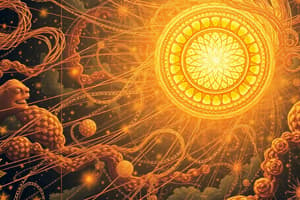Podcast
Questions and Answers
What does Newton's First Law of Motion state about an object's state of motion?
What does Newton's First Law of Motion state about an object's state of motion?
An object at rest stays at rest, and an object in motion stays in motion unless acted upon by a net external force.
Describe the relationship expressed in Newton's Second Law of Motion, F = ma.
Describe the relationship expressed in Newton's Second Law of Motion, F = ma.
The acceleration of an object is directly proportional to the net force acting on it and inversely proportional to its mass.
What does Newton's Third Law of Motion state about forces?
What does Newton's Third Law of Motion state about forces?
For every action, there is an equal and opposite reaction.
Differentiate between contact forces and non-contact forces with examples.
Differentiate between contact forces and non-contact forces with examples.
State Newton's Law of Universal Gravitation in simple terms.
State Newton's Law of Universal Gravitation in simple terms.
How is weight defined in relation to gravitational force?
How is weight defined in relation to gravitational force?
What formula is used to calculate work done by a force?
What formula is used to calculate work done by a force?
Define kinetic energy and its formula.
Define kinetic energy and its formula.
What is meant by the conservation of momentum?
What is meant by the conservation of momentum?
What is the formula for gravitational potential energy, and what does it depend on?
What is the formula for gravitational potential energy, and what does it depend on?
Flashcards are hidden until you start studying
Study Notes
Laws of Motion
- First Law (Inertia): An object at rest stays at rest, and an object in motion stays in motion at constant velocity unless acted upon by a net external force.
- Second Law (F=ma): The acceleration (a) of an object is directly proportional to the net force (F) acting on it and inversely proportional to its mass (m). Formulated as F = ma.
- Third Law (Action-Reaction): For every action, there is an equal and opposite reaction. Forces always occur in pairs.
Force and Acceleration
- Force: A vector quantity that causes an object to accelerate. Measured in Newtons (N).
- Types of Forces:
- Contact Forces: Forces that occur through direct contact (e.g., friction, tension).
- Non-contact Forces: Forces that act at a distance (e.g., gravitational, electromagnetic).
- Acceleration: Change in velocity over time. Can be due to a change in speed or direction.
Gravitational Force
- Newton's Law of Universal Gravitation: Every mass attracts every other mass with a force that is directly proportional to the product of their masses and inversely proportional to the square of the distance between their centers.
- Formula: F_gravity = G(m1*m2)/r², where G is the gravitational constant, m1 and m2 are the masses, and r is the distance between the centers.
- Weight: The gravitational force acting on an object, calculated as W = mg, where m is mass and g is the acceleration due to gravity (approximately 9.81 m/s² on Earth).
Energy and Work
- Work: The transfer of energy when a force is applied over a distance. Calculated as W = Fd cos(θ), where F is force, d is distance, and θ is the angle between the force and displacement.
- Kinetic Energy (KE): Energy of an object in motion, given by KE = 1/2 mv², where m is mass and v is velocity.
- Potential Energy (PE): Energy stored in an object due to its position in a force field (e.g., gravitational). For gravitational potential energy, PE = mgh, where h is height above a reference point.
- Conservation of Energy: In an isolated system, energy cannot be created or destroyed, only transformed from one form to another.
Momentum and Collisions
- Momentum (p): The product of an object's mass and velocity, p = mv. It is a vector quantity.
- Conservation of Momentum: In a closed system, the total momentum before an event (e.g., collision) equals the total momentum after.
- Types of Collisions:
- Elastic Collision: Both momentum and kinetic energy are conserved.
- Inelastic Collision: Momentum is conserved, but kinetic energy is not. Objects may stick together post-collision.
- Impulse: Change in momentum due to a force applied over time, given by Impulse = FΔt.
Laws of Motion
- First Law (Inertia): Objects will maintain their state of motion unless acted upon by an external force.
- Second Law (F=ma): Acceleration is dependent on the net force applied and inversely related to the object's mass, encapsulated in the formula F = ma.
- Third Law (Action-Reaction): Every action generates an equal and opposite reaction, indicating that forces are interrelated.
Force and Acceleration
- Force: A vector quantity that induces acceleration, measured in Newtons (N).
- Contact Forces: Forces that require physical contact between objects, such as friction or tension.
- Non-contact Forces: Forces that operate at a distance, including gravitational and electromagnetic forces.
- Acceleration: Defined as the rate of change of velocity, influenced by variations in both speed and direction.
Gravitational Force
- Newton's Law of Universal Gravitation: Describes the attraction between two masses as proportional to the product of their masses and inversely proportional to the square of the distance separating their centers.
- Gravitational Force Calculation: Expressed by the formula F_gravity = G(m1*m2)/r², with G representing the gravitational constant.
- Weight: Calculated as the gravitational force acting on an object using W = mg, where g is approximately 9.81 m/s² on Earth.
Energy and Work
- Work: Represents energy transfer that occurs when a force is exerted over a distance, calculated as W = Fd cos(θ).
- Kinetic Energy (KE): The energy associated with a moving object, determined with KE = 1/2 mv².
- Potential Energy (PE): Energy due to an object's position in a gravitational field, calculated with PE = mgh (where h is height).
- Conservation of Energy: Energy in an isolated system remains constant; it can only transform from one form to another.
Momentum and Collisions
- Momentum (p): Defined as the product of mass and velocity (p = mv), and is a vector quantity.
- Conservation of Momentum: In a closed system, total momentum is preserved before and after an event like a collision.
- Collision Types:
- Elastic Collision: Both momentum and kinetic energy are conserved during the interaction.
- Inelastic Collision: Momentum is conserved, but kinetic energy is not; objects may join post-collision.
- Impulse: Refers to the change in momentum caused by a force acting over time, quantified by Impulse = FΔt.
Studying That Suits You
Use AI to generate personalized quizzes and flashcards to suit your learning preferences.




